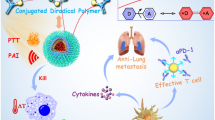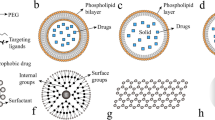Abstract
Tumor hypoxia has been considered to induce tumor cell resistance to radiotherapy and anticancer chemotherapy, as well as predisposing for increased tumor metastases. Therefore, strategies for the eradication of the hypoxic tumor are highly desirable. Photodynamic therapy (PDT) is a new technique that can be used to treat tumors using laser irradiation to photochemically activate a photosensitizer. Compared to traditional radiotherapy and chemotherapy, photodynamic therapy has many advantages, such as good selectivity, low toxicity, and less trauma and resistance. However, PDT is oxygen-dependent, and the lack of oxygen in hypoxic tumors renders photodynamic therapy ineffective. Cyanobacteria, the earliest photosynthetic oxygen-generating organisms, can utilize water as an electron donor to reduce CO2 into organic carbon compounds along with continuously releasing oxygen under sunlight. Inspired by this, herein, cyanobacteria were used as a living carrier of photosensitizer conjugated upconversion nanoparticles (UCNP) to construct a self-supplying oxygen PDT system. Improvement in the PDT efficiency for hypoxic tumors can be achieved as a result of in situ oxygen production by cyanobacteria under near-infrared (NIR) light using UCNP as a light harvesting antenna. A successful demonstration of this concept would be of great significance and could open the door to a new generation of carrier systems in the field of hypoxia-targeted drug transport platforms.

Similar content being viewed by others
References
Semenza, G. L. The hypoxic tumor microenvironment: A driving force for breast cancer progression. Biochim. Biophys. Acta 2016, 3, 382–391.
Harrison, L. B.; Chadha, M.; Hill, R. J.; Hu, K.; Shasha, D. Impact of tumor hypoxia and anemia on radiation therapy outcomes. Oncologist 2002, 7, 492–508.
Cummings, B. J.; Keane, T. J.; O’Sullivan, B.; Wong, C. S.; Catton, C. N. Epidermoid anal cancer: Treatment by radiation alone or by radiation and 5-fluorouracil with and without mitomycin C. Int. J. Radiat. Oncol. Biol. Phys. 1991, 21, 1115–1125.
Chen, Z. Z.; Niu, M.; Chen, G.; Wu, Q.; Tan, L. F.; Fu, C. H.; Ren, X. L.; Zhong, H. S.; Xu, K.; Meng, X. W. Oxygen production of modified core-shell CuO@ZrO2 nanocomposites by microwave radiation to alleviate cancer hypoxia for enhanced chemo-microwave thermal therapy. ACS Nano 2018, 12, 12721–12732.
Nishida, C. R.; Lee, M.; de Montellano, P. R. O. Efficient hypoxic activation of the anticancer agent AQ4N by CYP2S1 and CYP2W1. Mol. Pharmacol. 2010, 78, 497–502.
Reddy, S. B.; Williamson, S. K. Tirapazamine: A novel agent targeting hypoxic tumor cells. Expert Opin. Investig. Drugs 2009, 18, 77–87.
Sun, J. D.; Liu, Q.; Wang, J. L.; Ahluwalia, D.; Ferraro, D.; Wang, Y.; Duan, J. X.; Ammons, W. S.; Curd, J. G.; Matteucci, M. D. et al. Selective tumor hypoxia targeting by hypoxia-activated prodrug TH-302 inhibits tumor growth in preclinical models of cancer. Clin. Cancer Res. 2012, 18, 758–770.
Felsher, D. W. Cancer revoked: Oncogenes as therapeutic targets. Nat. Rev. Cancer 2003, 3, 375–379.
Agostinis, P.; Berg, K.; Cengel, K. A.; Foster, T. H.; Girotti, A. W.; Gollnick, S. O.; Hahn, S. M.; Hamblin, M. R.; Juzeniene, A.; Kessel, D. et al. Photodynamic therapy of cancer: An update. CA. Cancer J. Clin. 2011, 61, 250–281.
Dąbrowski, J. M.; Arnaut, L. G. Photodynamic therapy (PDT) of cancer: From local to systemic treatment. Photochem. Photobiol. Sci. 2015, 14, 1765–1780.
Cheng, Y. H.; Cheng, H.; Jiang, C. X.; Qiu, X. F.; Wang, K. K.; Huan, W.; Yuan, A. H.; Wu, J. H.; Hu, Y. Q. Perfluorocarbon nanoparticles enhance reactive oxygen levels and tumour growth inhibition in photodynamic therapy. Nat. Commun. 2015, 6, 8785.
Zhu, W. W.; Dong, Z. L.; Fu, T. T.; Liu, J. J.; Chen, Q.; Li, Y. G.; Zhu, R.; Xu, L. G.; Liu, Z. Modulation of hypoxia in solid tumor microenvironment with MnO2 nanoparticles to enhance photodynamic therapy. Adv. Funct. Mater. 2016, 26, 5490–5498.
Gordijo, C. R.; Abbasi, A. Z.; Amini, M. A.; Lip, H. Y.; Maeda, A.; Cai, P.; O’Brien, P. J.; DaCosta, R. S.; Rauth, A. M.; Wu, X. Y. Design of hybrid MnO2-polymer-lipid nanoparticles with tunable oxygen generation rates and tumor accumulation for cancer treatment. Adv. Funct. Mater. 2015, 25, 1858–1872.
Chen, Q.; Feng, L. Z.; Liu, J. J.; Zhu, W. W.; Dong, Z. L.; Wu, Y. F.; Liu, Z. Intelligent albumin-MnO2 nanoparticles as pH-/H2O2- responsive dissociable nanocarriers to modulate tumor hypoxia for effective combination therapy. Adv. Mater. 2016, 28, 7129–7136.
Cheng, H.; Zhu, J. Y.; Li, S. Y.; Zeng, J. Y.; Lei, Q.; Chen, K. W.; Zhang, C.; Zhang, X. Z. An O2 self-sufficient biomimetic nanoplatform for highly specific and efficient photodynamic therapy. Adv. Funct. Mater. 2016, 26, 7847–7860.
Gao, S. T.; Zheng, P. L.; Li, Z. H.; Feng, X. C.; Yan, W. X.; Chen, S. Z.; Guo, W. S.; Liu, D. D.; Yang, X. J.; Wang, S. X. et al. Biomimetic O2-evolving metal-organic framework nanoplatform for highly efficient photodynamic therapy against hypoxic tumor. Biomaterials 2018, 178, 83–94.
Chen, Z. W.; Wen, D.; Gu, Z. Cargo-encapsulated cells for drug delivery. Sci. China Life Sci. 2020, 63, 599–601.
Cohen, J. E.; Goldstone, A. B.; Paulsen, M. J.; Shudo, Y.; Steele, A. N.; Edwards, B. B.; Patel, J. B.; MacArthur Jr, J. W.; Hopkins, M. S.; Burnett, C. E. et al. An innovative biologic system for photon-powered myocardium in the ischemic heart. Sci. Adv. 2017, 3, e1603078.
Liu, K.; Xing, R. R.; Zou, Q. L.; Ma, G. H.; Möhwald, H.; Yan, X. H. Simple peptide-tuned self-assembly of photosensitizers towards anticancer photodynamic therapy. Angew. Chem., Int. Ed. 2016, 55, 3036–3039.
Qian, C. G.; Yu, J. C.; Chen, Y. L.; Hu, Q. Y.; Xiao, X. Z.; Sun, W. J.; Wang, C.; Feng, P. J.; Shen, Q. D.; Gu, Z. Light-activated hypoxiaresponsive nanocarriers for enhanced anticancer therapy. Adv. Mater. 2016, 28, 3313–3320.
Liu, Y. Y.; Liu, Y.; Bu, W. B.; Cheng, C.; Zuo, C. J.; Xiao, Q. F.; Sun, Y.; Ni, D. L.; Zhang, C.; Liu, J. N. et al. Hypoxia induced by upconversion-based photodynamic therapy: Towards highly effective synergistic bioreductive therapy in tumors. Angew. Chem., Int. Ed. 2015, 54, 8105–8109.
Schulze, A.; Harris, A. L. How cancer metabolism is tuned for proliferation and vulnerable to disruption. Nature 2012, 491, 364–373.
Huo, M. F.; Wang, L. Y.; Zhang, L. L.; Wei, C. Y.; Chen, Y.; Shi, J. L. Photosynthetic tumor oxygenation by photosensitizer-containing cyanobacteria for enhanced photodynamic therapy. Angew. Chem., Int. Ed. 2020, 59, 1906–1913.
Maisch, T.; Baier, J.; Franz, B.; Maier, M.; Landthaler, M.; Szeimies, R. M.; Bäumler, W. The role of singlet oxygen and oxygen concentration in photodynamic inactivation of bacteria. Proc. Natl. Acad. Sci. U. S. A. 2007, 104, 7223–7228.
Dahl, T. A.; Midden, W. R.; Hartman, P. E. Pure exogenous singlet oxygen: Nonmutagenicity in bacteria. Mutat. Res. 1988, 201, 127–136.
Vioque, A.; Transformation of cyanobacteria. In Transgenic Microalgae as Green Cell Factories. León, R.; Galván, A.; Fernández, E., Eds.; Springer: New York, 2007; 12–22.
Paso, K.; Kallevik, H.; Sjöblom, J. Measurement of wax appearance temperature using near-infrared (NIR) scattering. Energy Fuels 2009, 23, 4988–4994.
Peng, M. Y.; Zollfrank, C.; Wondraczek, L. Origin of broad NIR photoluminescence in bismuthate glass and bi-doped glasses at room temperature. J. Phys. Condens. Matter. 2009, 21, 285106.
Luo, G. F.; Chen, W. H.; Hong, S.; Cheng, Q.; Qiu, W. X.; Zhang, X. Z. A self-transformable pH-driven membrane-anchoring photosensitizer for effective photodynamic therapy to inhibit tumor growth and metastasis. Adv. Funct. Mater. 2017, 27, 1702122.
Acknowledgements
This work was supported by National Natural Science Foundation of China (Nos. 21977024, 21601046, and 31971304). Advanced Talents Incubation Program of the Hebei University (No. 801260201020). Funded by China Postdoctoral Science Foundation (No. 2019M650558), Beijing Postdoctoral Research Foundation and Beijing Chaoyang District Postdoctoral Research Fundation. We are grateful to Medical Comprehensive Experimental Center of Hebei University for the animal experiment.
Author information
Authors and Affiliations
Corresponding authors
Electronic Supplementary Material
12274_2020_3094_MOESM1_ESM.pdf
Cyanobacteria-based near-infrared light-excited self-supplying oxygen system for enhanced photodynamic therapy of hypoxic tumors
Rights and permissions
About this article
Cite this article
Zhang, Y., Liu, H., Dai, X. et al. Cyanobacteria-based near-infrared light-excited self-supplying oxygen system for enhanced photodynamic therapy of hypoxic tumors. Nano Res. 14, 667–673 (2021). https://doi.org/10.1007/s12274-020-3094-0
Received:
Revised:
Accepted:
Published:
Issue Date:
DOI: https://doi.org/10.1007/s12274-020-3094-0




